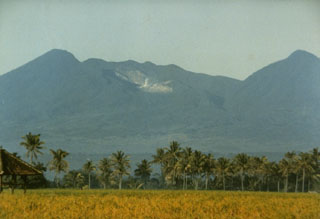Report on Papandayan (Indonesia) — 10 August-16 August 2011
Smithsonian Institution / US Geological Survey
Weekly Volcanic Activity Report, 10 August-16 August 2011
Managing Editor: Sally Sennert.
Please cite this report as:
Global Volcanism Program, 2011. Report on Papandayan (Indonesia) (Sennert, S, ed.). Weekly Volcanic Activity Report, 10 August-16 August 2011. Smithsonian Institution and US Geological Survey.
Papandayan
Indonesia
7.32°S, 107.73°E; summit elev. 2665 m
All times are local (unless otherwise noted)
On 13 August CVGHM reported that based on seismicity, deformation, geochemistry, and visual observations, the Alert Level for Papandayan was raised to 3 (on a scale of 1-4). During 1 June-12 August sulfur plumes rose 20-75 m above the vents. During the same period, seismicity increased with several hundreds of earthquakes detected per month. Temperature measurements in the Manuk thermal area indicated a relative increase from 29 June to 12 August and deformation measurements indicated inflation from 4 July to 10 August. Visitors and residents were not to venture within 2 km of the active crater.
Geological Summary. Papandayan is a complex stratovolcano with four large summit craters, the youngest of which was breached to the NE by collapse during a brief eruption in 1772 and contains active fumarole fields. The broad 1.1-km-wide, flat-floored Alun-Alun crater truncates the summit of Papandayan, and Gunung Puntang to the north gives a twin-peaked appearance. Several episodes of collapse have created an irregular profile and produced debris avalanches that have impacted lowland areas. A sulfur-encrusted fumarole field occupies historically active Kawah Mas ("Golden Crater"). After its first historical eruption in 1772, in which collapse of the NE flank produced a catastrophic debris avalanche that destroyed 40 villages and killed nearly 3000 people, only small phreatic eruptions had occurred prior to an explosive eruption that began in November 2002.
Source: Pusat Vulkanologi dan Mitigasi Bencana Geologi (PVMBG, also known as CVGHM)

